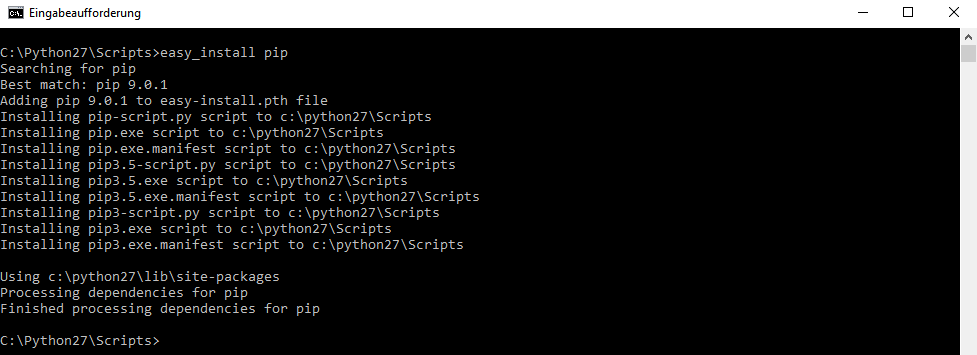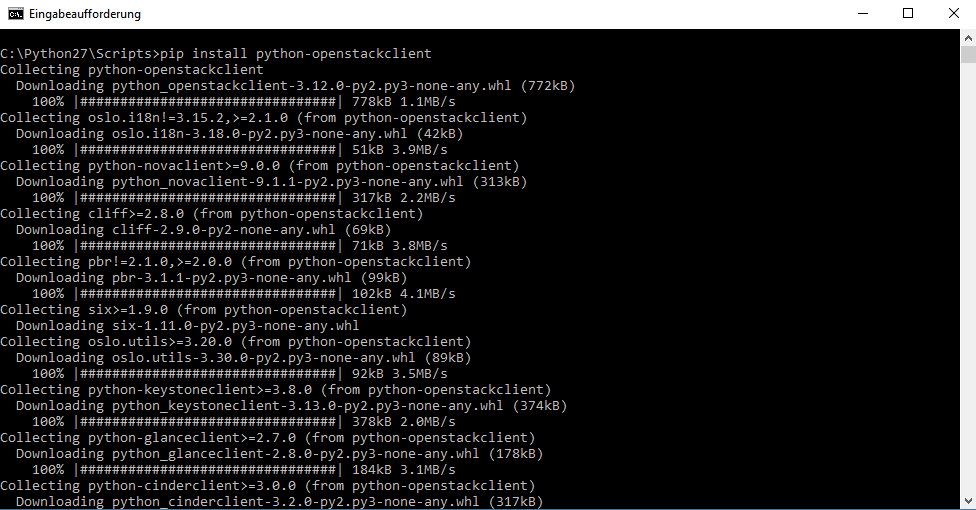Step 4: Your way to the console
Start
To make the administration of OpenStack as simple as possible, we recommend using the OpenStackClient.
For simple, non-recurring tasks, it may be easier to use the Horizon dashboard.
With recurring tasks, or when you want to manage a complex stack, it is better to use the OpenStack client and Heat.
This may be unfamiliar at first, but with some practice, you can quickly and efficiently manage stacks.
The client is helpful in the administration of the OpenStack environment. It contains Nova, Glance, Cinder, and Neutron.
As we use the client heavily in our Guided Tour, we will install it in the next step.
Installation
To install the OpenStackClient, you need at least Python 2.7 and Python Setuptools (which are included in macOS).
There are several ways to install the OpenStackClient. In our example, we use pip, and we recommend that you do the same.
“pip” is easy to use and you can also use it as an update manager for pip.
You can install the client as root (the administrative user), but that may cause problems. Therefore, you can install it in a virtual environment.
macOS
To install the OpenStackClient, you need to install pip. Start the console (Launchpad → Console) and type the following command:
$ easy_install pip
Searching for pip
Best match: pip 9.0.1
Adding pip 9.0.1 to easy-install.pth file
Installing pip script to /usr/local/bin
Installing pip2.7 script to /usr/local/bin
Installing pip2 script to /usr/local/bin
Using /usr/local/lib/python2.7/site-packages
Processing dependencies for pip
Finished processing dependencies for pip
Now you can install virtualenv.
$ pip install virtualenv
Collecting virtualenv
Downloading virtualenv-15.1.0-py2.py3-none-any.whl (1.8MB)
100% |????????????????????????????????| 1.8MB 619kB/s
Installing collected packages: virtualenv
Successfully installed virtualenv-15.1.0
After you have installed virtualenv, you can create the virtual environment.
$ virtualenv ~/.virtualenvs/openstack
New python executable in /Users/iNNOVO/.virtualenvs/openstack/bin/python
Installing setuptools, pip, wheel...done.
Now you may activate the virtual environment.
$ source ~/.virtualenvs/openstack/bin/activate
(openstack) $
Now you can install the OpenStack client.
(openstack) $ pip install python-openstackclient
Since we use other services in our documentation, you can install these clients as well.
(openstack) $ pip install python-heatclient python-designateclient python-octaviaclient
Now that you are done, you can deactivate your environment.
(openstack) $ deactivate
Finally, ensure that you can use the client outside of your virtual environment.
export PATH="$HOME/.virtualenvs/openstack/bin/:$PATH"
Now you can check that everything works. It should look like this:
$ type -a openstack
openstack is /home/iNNOVO/.virtualenvs/openstack/bin/openstack
Windows
If Python is already installed, you need to navigate to installation folder (standard installation folder C:\Python27\Scripts).
To install pip, use the command easy_install pip:

Once pip is installed, you can install the OpenStack client:

Linux (in our example Ubuntu)
First, install pip.
$ sudo apt-get install python3-pip
Reading package lists... Done
Building dependency tree
Reading state information... Done
Next, install virtualenv, which is required to set up your virtual environment.
$ sudo apt-get install python3-virtualenv
Reading package lists... Done
Building dependency tree
Reading state information... Done
Now you can create a virtual environment where you install the OpenStack client.
$ virtualenv ~/.virtualenvs/openstack
New python executable in /Users/iNNOVO/.virtualenvs/openstack/bin/python
Installing setuptools, pip, wheel...done.
Then you can activate your newly created environment.
$ source ~/.virtualenvs/openstack/bin/activate
(openstack) $
Once activated, you can install the OpenStackClient:
(openstack) $ pip install python-openstackclient
As we use Heat in our documentation, you will also install the Heat client.
(openstack) $ pip install python-heatclient
Once you are done, you can deactivate your virtual environment.
(openstack) $ deactivate
Finally, ensure that you can use your newly installed software.
export PATH="$HOME/.virtualenvs/openstack/bin/:$PATH"
Now you can check that everything works. It should look like this:
$ type -a openstack
openstack is /home/iNNOVO/.virtualenvs/openstack/bin/openstack
Credentials
For the OpenStack client to work, you need to supply it with the credentials.
You can download the credentials directly from the Horizon dashboard. After the login, click on your mail address in the right corner. Then click Download OpenStack RC File v3.
macOS | Linux
You need to source the credentials, which can be easily done with this command (IMPORTANT: The command can only be used in the folder where the RC file was downloaded):
source EXAMPLE.sh
Windows
To source the credentials on Windows, you must use PowerShell, Git for Windows or Linux on Windows.
If you use Git for Windows or Linux on Windows, you can use the same commands described in the macOS | Linux section.
source EXAMPLE.sh
If you use PowerShell, you need to set each variable individually. All required variables are in the previously downloaded Beispiel.sh. To set the variables, use the following command:
set-item env:OS_AUTH_URL -value "https://identity.optimist.gec.io/v3"
set-item env:OS_PROJECT_ID -value "Projekt ID eintragen"
set-item env:OS_PROJECT_NAME -value "Namen eintrage"
set-item env:OS_USER_DOMAIN_NAME -value "Default"
set-item env:OS_USERNAME -value "Usernamen eintragen"
set-item env:OS_PASSWORD -value "Passwort eingeben"
set-item env:OS_USER_DOMAIN_NAME -value "Default"
set-item env:OS_REGION_NAME -value "fra"
set-item env:OS_INTERFACE -value "public"
set-item env:OS_IDENTITY_API_VERSION -value "3"
Conclusion
You now have an OpenStack client with working credentials, and can test the commands.
To get an overview of all OpenStack commands, run the following command:
openstack --help